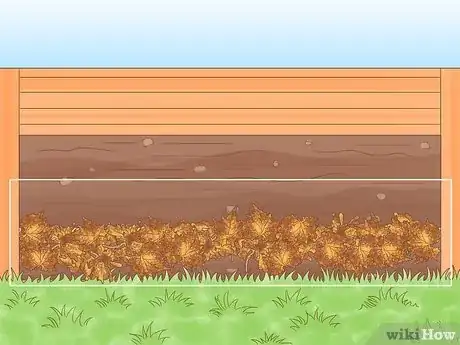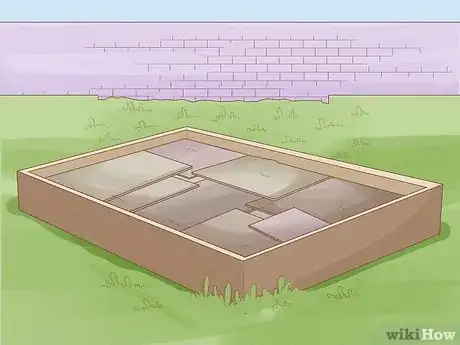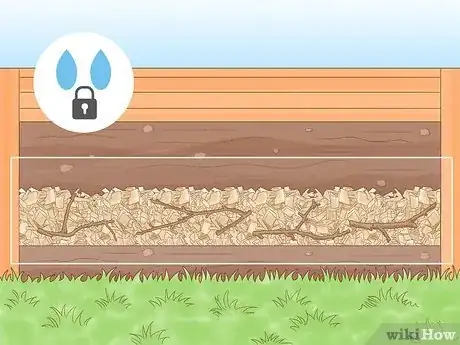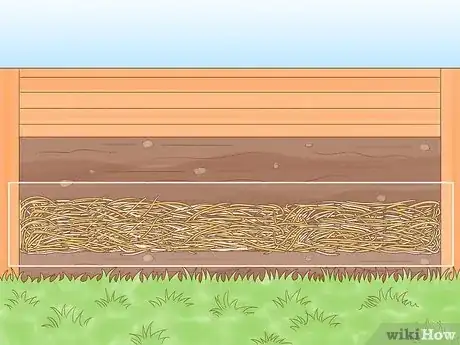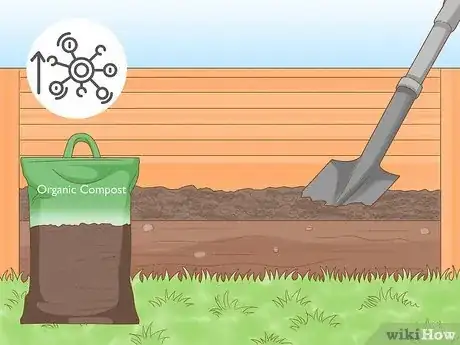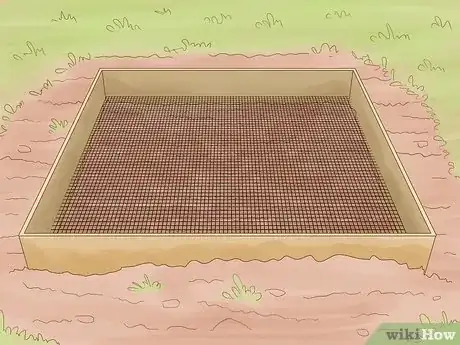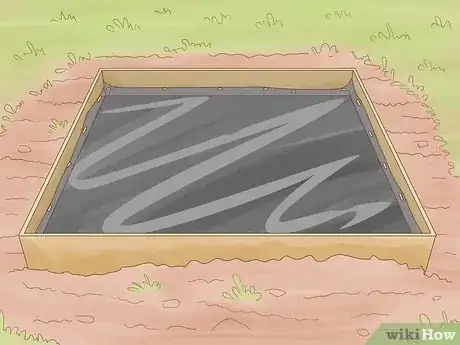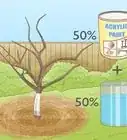This article was co-authored by Ben Barkan and by wikiHow staff writer, Jessica Gibson. Ben Barkan is a Garden and Landscape Designer and the Owner and Founder of HomeHarvest LLC, an edible landscapes and construction business based in Boston, Massachusetts. Ben has over 12 years of experience working with organic gardening and specializes in designing and building beautiful landscapes with custom construction and creative plant integration. He is a Certified Permaculture Designer, is licensed Construction Supervisor in Massachusetts, and is a Licensed Home Improvement Contractor. He holds an associates degree in Sustainable Agriculture from the University of Massachusetts Amherst.
There are 9 references cited in this article, which can be found at the bottom of the page.
This article has been viewed 9,445 times.
You've prepped your garden area and built raised beds. What comes next? While you could simply fill the beds with soil, this can be costly. Plus, you may have concerns you'd like to address—rodents in your garden, weed prevention, or water drainage for instance. To find the best material for your beds, read through our comprehensive list of options and suggestions for when you should use them.
Steps
Leaves
-
Spread leaves to insulate the garden and add bulk to the bed. Leaves are a fantastic free resource that break down and add nutrients to your garden soil. You can spread whole leaves on the bottom of the bed or shred them with your mower first so they'll break down faster. The leaves act as an insulating layer that can protect the roots of plants during the winter.[1] X Research source
- If you don't have deciduous trees in your yard, check with your city or local community gardens. They often offer free leaf delivery to gardeners.
Grass clippings
-
Put dry clippings into the bed to add bulk and organic nutrients to the soil. Avoid using fresh, wet grass clippings since these can clump together and form an almost waterproof barrier that stops drainage. Instead, let the grass clippings dry completely before you spread them on the bottom of the bed. As they break down, the clippings turn into organic material that keeps the soil healthy.[2] X Research source
- It's really important that you use grass that hasn't been treated with herbicides or pesticides since these could leach into your garden soil.
Cardboard
-
Lay cardboard on the bed to smother weeds and provide insulation. The cardboard prevent weeds from shooting up through the soil and they add a layer of insulation that keeps plant roots warm during the winter months. Since cardboard absorbs water, it can also keep the soil moist, so the plant roots don't dry out.[3] X Trustworthy Source Penn State Extension Educational organization dedicated to delivering science-based information to people, businesses, and communities Go to source
- You only need a single layer of cardboard to block weeds. Since it will break down after a season, you will need to replace the cardboard the next time you top up your raised bed's soil.
Newspaper
-
Arrange 5 to 6 layers of newspaper to prevent weeds from popping up. Newspaper acts like cardboard—it blocks the weeds and breaks down into organic material. It's also free and easy to find, so it's a handy filler for your raised bed garden. Just ensure that you completely cover the bottom of the bed, so weeds can't find a way to creep up.[4] X Research source
- Most newspapers are now printed with soy-based ink, so they're not harmful when they break down. However, don't use glossy, colorful printed inserts which might not use soy-based ink.
Untreated lumber, wood chips, or sticks
-
Wood chips or branches insulate the soil and maintain moisture levels. If you live in a dry area, it may be hard to keep the soil at the right moisture level. Non-pressure-treated lumber, wood chips, sticks, or branches can hold in moisture. They'll also insulate the garden, so the plant roots don't freeze during the winter.[5] X Research source
- Wood chips, sticks, or branches break down really slowly, but they add bulk to your soil. This means you won't have to fill up your raised beds with soil as often.
Straw
-
Straw is an inexpensive filler that insulates the bottom of your garden bed. It's lightweight, so it's easy to spread. Straw acts as an insulating layer to protect plant roots from extreme cold or heat. It also smothers weeds, so you'll have less garden maintenance to worry about.[6] X Research source
- When you buy straw, ensure that it's not hay, which contains seeds. You don't want grain sprouting in your garden bed!
Compost
-
Fill half the bed with compost to add rich nutrients to your garden soil. You can use compost from your yard or buy high-quality compost from a garden supply store. Fill the rest of the bed with quality topsoil and mix it in a shovel, so you have a soil combination of 50% compost and 50% topsoil.[7] X Research source
- You can use straight compost without any soil mixed in if your compost is well-aged and no longer smells.
- The soil level in your raised bed garden will sink a few inches every year as the soil settles. Just add a few inches of compost every year to replace it and keep your soil healthy.
Hardware cloth
-
Line the bottom of the bed with a metal hardware cloth to deter rodents. If you've got gophers or moles trying to sabotage your garden, hardware cloth can prevent them from digging under your beds. Staple a layer of metal hardware cloth to the very bottom of the bed before you fill it in with soil. This barrier stops rodents from digging underneath your garden.[8] X Research source
- Purchase metal hardware cloth at your local hardware store, farming supply store, or online.
- If you've dealt with pests in the past, it's also a good idea to put up a fence around the beds, so the gophers can't climb over the barrier. Make your little garden fence at least 1 foot (0.30 m) high.
Landscape fabric
-
Spread landscape fabric to prevent weeds and encourage drainage. You might see landscape fabric called weed mat. It acts as a barrier to stop weeds or roots from nearby trees from working their way into your garden bed. Landscape fabric is usually effective for a few seasons before you need to replace it.[9] X Research source
- Landscape fabric keeps the soil in place, but water can easily drain away from the soil. This is useful if you've got clay soil for instance.
- To keep the landscape fabric in place before you add the soil, staple the material to the sides of the raised bed.
Burlap
-
Burlap provides good drainage and weed prevention. It acts like landscape fabric, but it's less expensive. The woven fabric keeps soil in place but allows water to drain. It can also block weeds from growing in the bed. Because burlap is made from jute, hemp, or cotton, it will decompose in the garden bed.[10] X Research source
- You can easily cut burlap bags and lay the material flat in your beds.
Food-grade plastic
-
Line the garden bed if you're concerned about toxins in the soil. If your garden soil might be contaminated by industrial run-off or toxins, get it tested. To be on the safe side, spread food-grade plastic sheeting along the bottom and sides of the bed. Then, staple it in place before you fill the bed with soil.[11] X Research source
- Only use plastic sheeting if you're concerned about toxic soil. The plastic sheeting does prevent adequate drainage, and moisture can get trapped between the plastic and the wood of the bed. This can cause it to rot faster.
You Might Also Like





 6 Ways to Water Your Plants While You're on Vacation
6 Ways to Water Your Plants While You're on Vacation







 How and When to Prune Laurel Bushes and Hedges
How and When to Prune Laurel Bushes and Hedges
References
- ↑ https://homegardenkeeping.com/bottom-of-a-raised-garden-bed/
- ↑ https://homegardenkeeping.com/bottom-of-a-raised-garden-bed/
- ↑ https://extension.psu.edu/how-to-construct-a-raised-bed-in-the-garden
- ↑ https://www.greenhousetoday.com/cheapest-way-to-fill-raised-beds/
- ↑ https://www.abc.net.au/gardening/factsheets/layering-a-vegie-bed/9432498
- ↑ https://homegardenkeeping.com/bottom-of-a-raised-garden-bed/
- ↑ https://www.uvm.edu/news/story/thinking-about-raised-bed-garden
- ↑ https://extension.colostate.edu/topic-areas/natural-resources/managing-pocket-gophers-6-515/
- ↑ https://www.bobvila.com/articles/landscape-fabric/
About This Article

